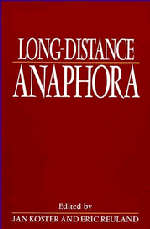Book contents
- Frontmatter
- Contents
- List of contributors
- Preface
- 1 Long-distance anaphora: an overview
- 2 Containment and connectedness anaphors
- 3 Long-distance reflexives and the typology of NPs
- 4 Contextual determination of the anaphor/pronominal distinction
- 5 On the interaction between antecedent-government and binding: the case of long-distance reflexivization
- 6 Binding in Polish
- 7 Anaphors in binary trees: an analysis of Czech reflexives
- 8 Latin long-distance anaphora
- 9 Prepositions, binding and θ-marking
- 10 Locality, parameters and some issues in Italian syntax
- 11 Long-distance binding in Finnish
- 12 The primacy condition of anaphora and pronominal variable binding
- 13 The local nature of the long-distance reflexive in Chinese
- 14 Anaphors and logophors: an argument structure perspective
- References
- Index
11 - Long-distance binding in Finnish
Published online by Cambridge University Press: 01 June 2011
- Frontmatter
- Contents
- List of contributors
- Preface
- 1 Long-distance anaphora: an overview
- 2 Containment and connectedness anaphors
- 3 Long-distance reflexives and the typology of NPs
- 4 Contextual determination of the anaphor/pronominal distinction
- 5 On the interaction between antecedent-government and binding: the case of long-distance reflexivization
- 6 Binding in Polish
- 7 Anaphors in binary trees: an analysis of Czech reflexives
- 8 Latin long-distance anaphora
- 9 Prepositions, binding and θ-marking
- 10 Locality, parameters and some issues in Italian syntax
- 11 Long-distance binding in Finnish
- 12 The primacy condition of anaphora and pronominal variable binding
- 13 The local nature of the long-distance reflexive in Chinese
- 14 Anaphors and logophors: an argument structure perspective
- References
- Index
Summary
Summary
In this chapter the anaphoric/pronominal system of Finnish will be discussed. A close look at Finnish anaphors and pronouns leads to the conclusion that the binding relations in Finnish can only be adequately accounted for if we assume that there are two kinds of binding domains, each with its own binding rules. Therefore, a theory of binding will be proposed which distinguishes between binding in a small domain, i.e. local binding, and binding in a larger domain, i.e. long-distance binding.
Introduction
In Chomsky (1981) a binding theory is proposed which states that an anaphor must be bound within the minimal maximal projection containing the anaphor, a governor for the anaphor and a subject or Agr accessible to the anaphor (called the governing category of the anaphor), while pronouns must be free within this domain. However, various languages, e.g. Icelandic and Italian, contain anaphors that can be bound by an antecedent outside this domain (cf. Yang (1984)). Although these anaphors obviously do not obey Chomsky's binding theory, they are very systematic in their behaviour, and hence have to be included in a general theory of binding. This raises the important question of how this is to be done: is long-distance binding (binding outside Chomsky's governing category) to be considered as local binding in a larger domain, or are there any fundamental differences between long-distance binding and local binding? An inspection of the Finnish anaphoric/pronominal system indicates the latter.
- Type
- Chapter
- Information
- Long Distance Anaphora , pp. 231 - 244Publisher: Cambridge University PressPrint publication year: 1991
- 1
- Cited by



